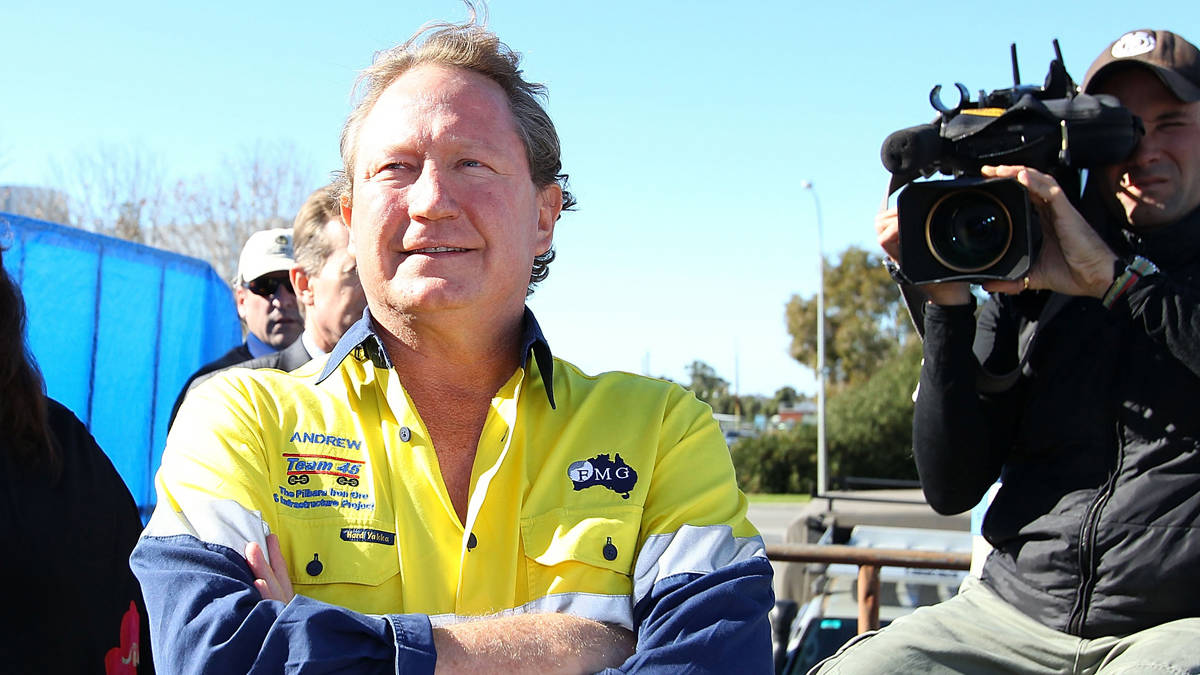Ground Breakers: Twiggy bags a lowly $950m as FMG dividend cut hard; Evolution profit dips on cost pressures

Pic: Getty
Andrew Forrest will pocket some $950 million in cold hard cash in his first half dividend from Fortescue Metals Group (ASX:FMG) as the Pilbara major reported a US$2.8 billion profit.
FMG will pay $0.86 a share after generating US$4.76 billion in underlying EBITDA in the December half, down from US$6.64b in the first half of 2021. FMG paid $1.47 a share in the 2021 half year and $2.11 for the full year in August.
Profits were also down 32% on 2021 levels, which was to be expected after rising discount rates for FMG’s lower grade ore emerged through the second half of 2021.
FMG’s revenue from its Pilbara operations, where it shipped a record 93.1wmt of ore, fell 16% from US$114/02/t to US$95.58/t year on year while its C1 costs rose 20% from US$12.78/t to US$15.28/t due to inflationary pressures.
Benchmark iron ore prices have since risen from US$87/t to US$150/t in recent days before a big drop yesterday caused by clampdowns by Chinese authorities on prices it doesn’t like the look of.
Whether China is able to keep those prices low while also stimulating steel demand with rate cuts is a matter of conjecture.
FMG’s half-year announcement will see total payouts come to $2.65 billion, a 70% payout of NPAT, a day after fellow Pilbara iron ore giant BHP (ASX:BHP) dazzled with a monster US$7.6b ($10.7b) divvie.
FMG boss Elizabeth Gaines described it as an “outstanding result”, with the 22Mtpa Iron Bridge Magnetite Mine also remaining on track for a December 2022 opening.
It has come amid news reports of more executive departures at the firm in recent days, with FMG’s green initiatives through its Fortescue Future Industries arm also dominating the press through a series of announcements since launching last year.
“Safety is our number one priority and the team’s continued focus resulted in further improvement in our TRIFR safety performance while managing the ongoing challenges resulting from COVID-19,” FMG’s outgoing CEO Gaines said.
“We have a robust COVID-19 management plan in place to prioritise the health and safety of our team and the communities in which we operate, and this is constantly reviewed considering Commonwealth and State health requirements.
“We have continued to reinvest in the business and invest in growth. Our major project, Iron Bridge, is progressing well with first production scheduled in December 2022. We remain focused on managing industry cost pressures and challenges posed by Western Australia’s ongoing border restrictions, and we are working closely with the Western Australian Government and relevant authorities to ensure we have access to the specialist skills required.
“During the half, Fortescue Future Industries continued to advance a portfolio of renewable energy and green hydrogen project opportunities, while growing its green technology capabilities. As Fortescue continues its transition to a vertically integrated green energy and resources company, Fortescue Future Industries will be a key enabler of our industry-leading targets to decarbonise our operations by 2030 and to remove net emissions from our entire value chain by 2040.”
FFI is expected to spend US$400-600m this financial year, including US$100-200m in capex and US$300-400m in opex and spent US$242m in the first half of 2022.
Funded through 10% of FMG’s profits, FFI has an unutilised funding commitment of US$651m at the end of H1 2022.
FMG share price today:
Busy Evolution halves dividend as profit falls from 2020 highs
Gold producer Evolution Mining (ASX:EVN) has trimmed its half year dividend from 7c in H2 2020 to 3c for H1 2021 after its statutory profit dropped 60% year on year from $228.7 million to $90.8m.
The $55 million payout will take total payouts to shareholders just shy of the $1b mark since the miner first delivered a dividend in 2013.
EVN’s underlying profit came in at $100.1m, down on the $234m in the second half of 2020. That is not wholly surprising, given costs have been higher and gold prices were at record levels in the prior corresponding period.
But inflation also had an impact, with input prices adding 3% to its operating costs and the company reporting a material increase in cost pressures in the past six months.
Labour costs are expected to rise 4-5% over the next year, while EVN’s power contracts are also up for negotiation in December.
At US$1853/oz today they are still generating good margins for producers like EVN, although gold did drop overnight after two strong days of trade as fears of Russia invading Ukraine receded.
EVN delivered EBITDA of $393.3m (2020: $514.6m) but has maintained cost and production guidance through the second half of 2021-22 and expects it to be materially stronger because of the addition of Glencore’s $1 billion Ernest Henry copper-gold mine share to its portfolio.
The deal, which closed on January 6, will help both expand gold production and reduce costs due to the copper credits that often see Ernest Henry report significant negative all-in sustaining costs.
Evolution also closed the $400 million acquisition of the Kundana mines from Northern Star (ASX:NST) next to its Mungari operations in Kalgoorlie.
The corporate transactions mean EVN has now trimmed its portfolio from six to seven mid-sized operations to four large hubs in recent years at Cowal, Ernest Henry, Mungari and the struggling Red Lake mine in Canada.
Those four operations, which contain a combined reserve of 10.3Moz and resources of more than 29Moz, are set to underpin a projected rise in production from 670,000-725,000oz at $1135-1195/oz in FY22 to 855,000-915,000oz at $990-1050/oz in FY24, with copper tonnes increasing from 38,000t this year to 60,000t in 2023 and 2024.
Evolution Mining share price today:

UNLOCK INSIGHTS
Discover the untold stories of emerging ASX stocks.
Daily news and expert analysis, it's free to subscribe.
By proceeding, you confirm you understand that we handle personal information in accordance with our Privacy Policy.








